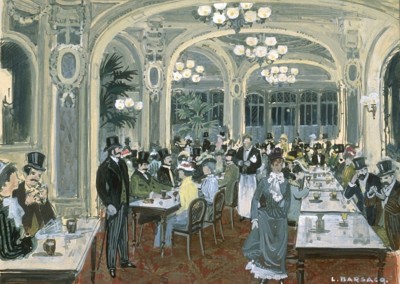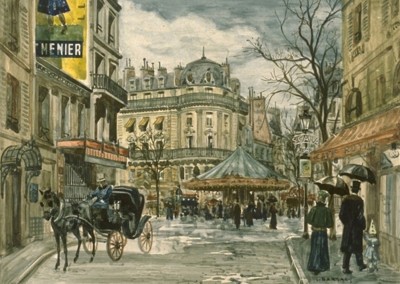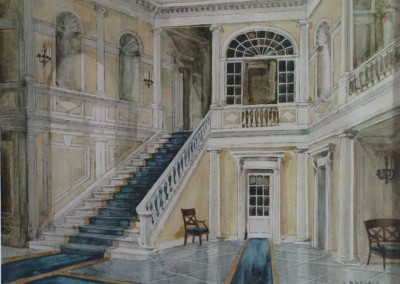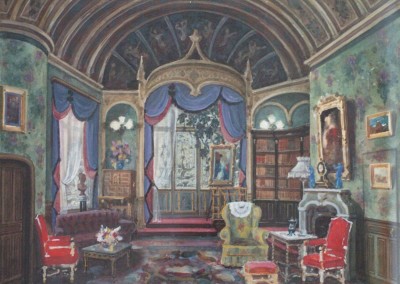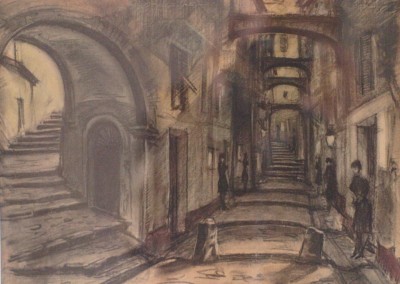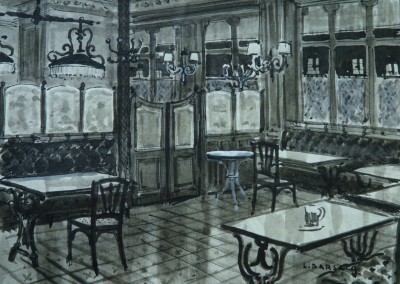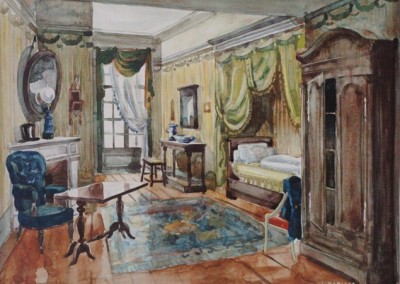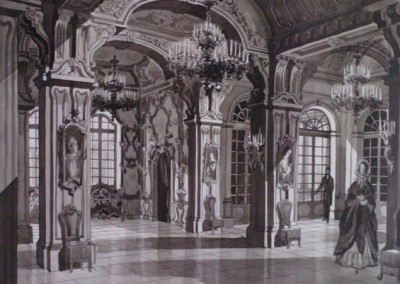Léon Barsacq
(1906-1969)
Léon Barsacq (1906-1969)
Décorateur de cinéma, né en 1906 en Crimée (Russie) et mort à Paris en 1969
Arts Décoratifs à Paris, diplôme d’Architecte
1931 à 1936 assistant décorateur: André Andreïev, Jean Perrier
Décorateur des Films :
1938 La Marseillaise (J. Renoir)
1943 Lumière d’été (J. Grémillon) Les Mystères de Paris(J.Baroncelli)
1944 Les Enfants du Paradis (M. Carné)
1945 Boule de Suif (Christian-Jaque)
1946 L’Idiot (G. Lampin)
1947 Les Dernières Vacances (R. Leenhardt) Le Silence est d’or (R. Clair)
1948 Pattes blanches (J. Grémillon)
1949 La Beauté du diable (René Clair)
1950 Le Château de verre (R. Clément) Maya (Raymond Bernard
1951 Deux sous de violettes (J. Anouilh)1952 Violettes impériales (R. Pottier) Belles de nuit
(R. Clair)-Rome onze heures (Guiseppe de Santis)
1953 Le Grand Jeu (R. Siodmak) Bel ami (L. Daquin)
1954 Les Diaboliques (H-G. Clouzot)
1955 Les Grandes Manoeuvres (R. Clair) The Ambassadors daughter(Krasna)
1956 Till l’Espiègle (Gérard Philippe) Michel Strogoff (C. Gallone)
1957 Porte des Lilas (R. Clair) Pot-bouille (J. Duvivier)
1959 Recours en grâce (L. Benedek)
1961 Les joies de la famille (Philippe Hériat), une pièce de théâtre
1962 Le Jour le plus long, co-décorateur, (D. Zanuck, B.Wicki ) La Rancune (B. Wicki )
1963 Trois chambres à Manhattan (M. Carné)
1966 J’ai tué Raspoutine (R. Hossein)
1968 Phèdre (P. Jourdan)
Le décor, conception du réel “imité”, avec le minimum de paradoxe que, pour le film, le décor le plus réussi est celui qu’on remarque le moins.
C’est à une telle réussite que Léon Barsacq atteignait et pourtant, pour un oeil exercé, ce qu’il construisait portait la marque de sa manière. Ainsi, pour le film Porte des Lilas il avait bâti tout un ensemble de rues et de ruelles dont peu de spectateurs, je pense, ont pu mettre en doute la réalité.
De ces grands maquilleurs du réel que sont les décorateurs (ou plutôt les architectes) du cinéma, vous trouverez ici l’histoire racontée par un maître de leur art. Grâce au livre que Léon Barsacq rédigea dans les dernières années de sa vie, est gardée la mémoire de ces oeuvres dont il ne reste que des ombres fixées sur une pellicule fragile.
René Clair de l’Académie Française
2011 La Capitale Galerie, Paris (exposition personelle)
2013 La Capitale Galerie, Paris “oeuvres des années 50-70”, groupe expo
2014 La Capitale Galerie, Paris “oeuvres sur papier” groupe expo
2015 La Capitale Galerie, Paris “oeuvres sur papier” groupe expo
***
Léon Barsacq was one of the leading art directors of his time. Yet his greater importance will almost certainly lie in his ideas about set design as an art and in his documentation of the history of the films design.
The Russian-born Barsacq trained in architecture and decorative art in Paris before becoming an assistant designer on films by andrei Andrejew and others. Among his early work as an art director, the most memorable settings appear in Marcel Carné’s and Jacques Prévert’s “Les enfants du paradis”, for which Barsacq collaborated with Alexandre Trauner andRaymond Gabutti. In its density of detail, its visual richness and atmosphere, this was a masterpiece of style defying the austerity of occupied France.
In “Les enfants du paradis” and other of his early films, such as “La Marseillaise”, directed by Jean Renoir, the elaboration of settings did not, perhaps, totally comply with Barsacq’s premise that design should subordinate itself to narrative, simply lending atmospheric support.
But as the complexities of style which dominate Occupation films gave way to a simpler imagery in the 1950’s, Barsacq’s work developed a more sketchlike style. His best sets achieve a delicate balance beteween realism and artifice. Barsacq was an elegant Beaux Arts dreftsman whose drawings reflected his ability to find the essence of a setting without resorting to obvious trickery.
Barsacq’s closest liaisons were with René Clair and Marcel Carné. Clair said of his designs, “reality paled alongside its imitation “Jean Renoir, too, was among his collaborators. Like the directors wiht whom he worked.
Barsacq drew inspiration from such painters as Daumier, for the Boulvard du Crime in “Les Enfants du paradis” and Breughel, for the sets in “Les Aventures de Till L’Espiegle”. Barsacq worked among the French pioneers in the use of color during the early 1950s, the so-called “heroic”period of color film. Early color films with sets by Barsacq include Richard Pottier’s “Violettes impériales” and Raymond Bernard’s “La Dame aux camélias.” The expensive Technicolor procces and the uncertain Belgian Gevacolor system were used until the introduction of the more controllable Eastmancolor, for which Barsacq designed sets in Calir’s “Les Grandes Manoeuvres.”
By limiting his palette of colors to neutral tones with only occasional use of strong color, Barsacq confirmed the aesthetic merit of color in pruducing atmospheric effects.
Barsacq’s designs of the 1960s for films such as “The Longest day” and “Trois Chambres à Manhattan,” have been treated with less interest by critics than his earlier work. This was due partly to the overwhelming fashion for cinema verité in the later 1950s and early 1960s, which attempted to abandon artificiality and contrivance in design and all other aspects of the film. But as a historian of film design, Barsacq was highly productive in his later years.
Published in 1970, his book “Le Décor de film” not only contains a wealth of information, but also proposees a clear aesthetic postulate on film design and , consequently, has become the strandard text on its subject. Gregory Vololato
2011 La Capitale Gallery, Paris (solo exhibition)
2013 La Capitale Gallery, Paris « Peintures des années 50-70 », groupe expo
2014 La Capitale Gallery, Paris, groupe expo “works on papier”
2015 La Capitale Gallery, Paris ” works on papier” groupe expo

